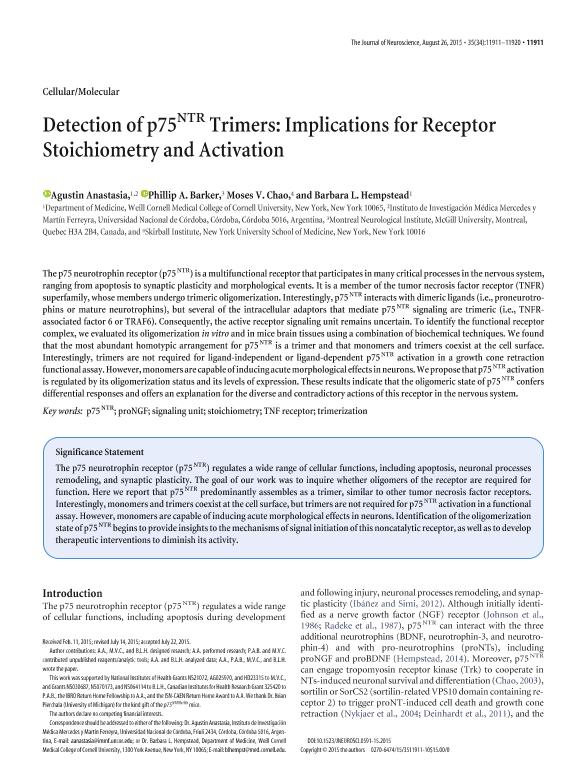Artículo
Detection of p75NTR trimers: Implications for receptor stoichiometry and activation
Fecha de publicación:
26/08/2015
Editorial:
Society for Neuroscience
Revista:
Journal of Neuroscience
ISSN:
0270-6474
e-ISSN:
1529-2401
Idioma:
Inglés
Tipo de recurso:
Artículo publicado
Clasificación temática:
Resumen
The p75 neurotrophin receptor (p75NTR) is a multifunctional receptor that participates in many critical processes in the nervous system, ranging from apoptosis to synaptic plasticity and morphological events. It is a member of the tumor necrosis factor receptor (TNFR) superfamily, whose members undergo trimeric oligomerization. Interestingly, p75NTR interacts with dimeric ligands (i.e., proneurotro-phins or mature neurotrophins), but several of the intracellular adaptors that mediate p75NTR signaling are trimeric (i.e., TNFR-associated factor 6 or TRAF6). Consequently, the active receptor signaling unit remains uncertain. To identify the functional receptor complex, we evaluated its oligomerization in vitro and in mice brain tissues using a combination of biochemical techniques. We found that the most abundant homotypic arrangement for p75NTR is a trimer and that monomers and trimers coexist at the cell surface. Interestingly, trimers are not required for ligand-independent or ligand-dependent p75NTR activation in a growth cone retraction functional assay. However, monomers are capable of inducing acute morphological effects in neurons. We propose that p75NTR activation is regulated by its oligomerization status and its levels of expression. These results indicate that the oligomeric state of p75NTR confers differential responses and offers an explanation for the diverse and contradictory actions of this receptor in the nervous system.
Palabras clave:
P75NTR
,
PRONGF
,
SIGNALING UNIT
,
STOICHIOMETRY
,
TNF RECEPTOR
,
TRIMERIZATION
Archivos asociados
Licencia
Identificadores
Colecciones
Articulos(INIMEC - CONICET)
Articulos de INSTITUTO DE INV. MEDICAS MERCEDES Y MARTIN FERREYRA
Articulos de INSTITUTO DE INV. MEDICAS MERCEDES Y MARTIN FERREYRA
Citación
Anastasia Gonzalez, Agustin; Barker, Phillip A.; Chao, Moses V.; Hempstead, Barbara L.; Detection of p75NTR trimers: Implications for receptor stoichiometry and activation; Society for Neuroscience; Journal of Neuroscience; 35; 34; 26-8-2015; 11911-11920
Compartir
Altmétricas




